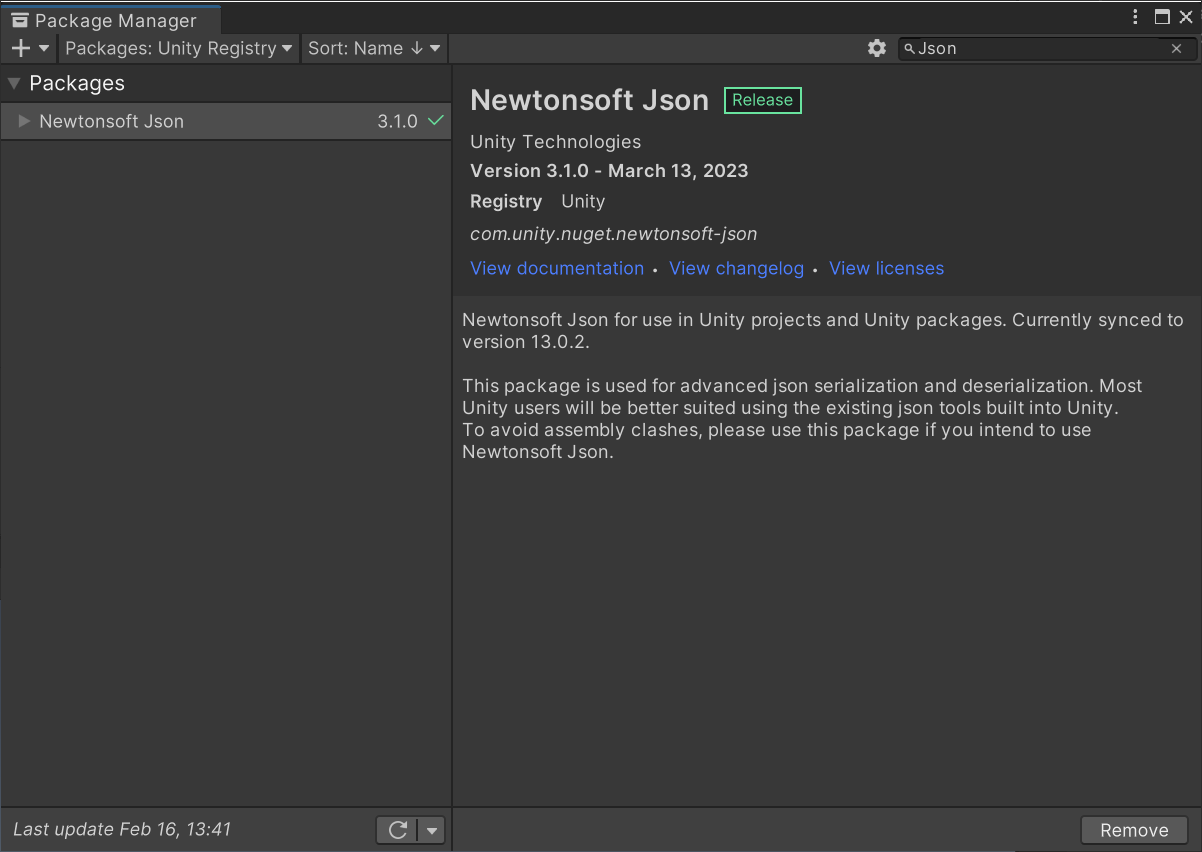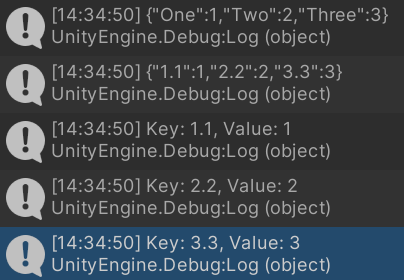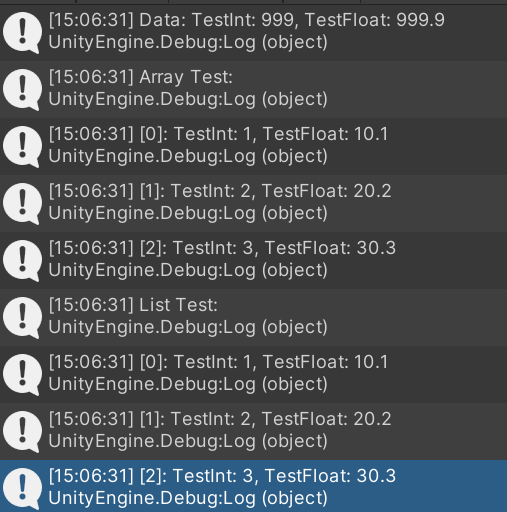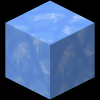UD3L6——Newtonsoft.Json
Newtonsoft.Json
Newtonsoft.Json,通常也被称为 Json.NET ,是一个非常流行的用于处理 JSON 数据的高性能 .NET 库。
官网:Json.NET - Newtonsoft
官方文档:Json.NET Documentation
关于 Newtonsoft.Json 进阶用法可以参考此视频:分享一些Newtonsoft.Json的实用功能与技巧_哔哩哔哩_bilibili
导入 Newtonsoft.Json
Newtonsoft.Json 已经提供了针对 Unity 的定制版本,因此,将 Newtonsoft.Json 导入到 Unity 项目非常简单
使用 Newtonsoft.Json 序列化
JsonConvert.SerializeObject() 是 Newtonsoft.Json 提供的序列化方法
参数一:要序列化的对象
参数二:Formatting 枚举,如果传入 Formatting.Indented 则返回的 Json 是有换行和缩进(两个空格)形式的
返回值:序列化出来的 Json 字符串
示例:
1 2 3 4 5 6 7 8 9 10 11 12 13 14 15 16 17 18 19 20 21 22 23 24 25 26 27 28 29 30 31 32 33 34 35 36 37 38 39 40 41 42 43 44 45 46 47 48 49 50 51 52 53 54 55 56 using UnityEngine;using Newtonsoft.Json;using System.Collections.Generic;public class JsonTest : MonoBehaviour { void Start () { JsonDataTest test = new () { hp = 1 , sex = false , speed = 16.66f , resName = "Airplane/Airplane1" , subData = new () { testInt = 1 , testFloat = 2 }, TestNull = null , subDatas = new SubData[] { new () { testInt = 10 , testFloat = 1.1111f }, new () { testInt = 20 , testFloat = 22.222f }, new () { testInt = 30 , testFloat = 333.33f }, }, subDataDic = new Dictionary<string , SubData>() { { "Lihua" , new () { testInt = 100 , testFloat = -1.0f } }, { "xiaohong" , new () { testInt = 200 , testFloat = -2.0f } }, } }; string json1 = JsonConvert.SerializeObject(test); Debug.Log($"Json without Format: \n{json1} " ); string json2 = JsonConvert.SerializeObject(test, Formatting.Indented); Debug.Log($"Json with Format: \n{json2} " ); } } public class JsonDataTest { public int hp; public bool sex; public float speed; public string resName; public SubData subData; public SubData TestNull; public SubData[] subDatas; public Dictionary<string , SubData> subDataDic; } public class SubData { public int testInt; public float testFloat; }
输出:
1 2 3 4 5 6 7 8 9 10 11 12 13 14 15 16 17 18 19 20 21 22 23 24 25 26 27 28 29 30 31 32 33 34 35 36 37 38 39 40 Json without Format: { "hp" : 1 , "sex" : false , "speed" : 16.66 , "resName" : "Airplane/Airplane1" , "subData" : { "testInt" : 1 , "testFloat" : 2.0 } , "TestNull" : null , "subDatas" : [ { "testInt" : 10 , "testFloat" : 1.1111 } , { "testInt" : 20 , "testFloat" : 22.222 } , { "testInt" : 30 , "testFloat" : 333.33 } ] , "subDataDic" : { "Lihua" : { "testInt" : 100 , "testFloat" : -1.0 } , "xiaohong" : { "testInt" : 200 , "testFloat" : -2.0 } } } Json with Format: { "hp" : 1 , "sex" : false , "speed" : 16.66 , "resName" : "Airplane/Airplane1" , "subData" : { "testInt" : 1 , "testFloat" : 2.0 } , "TestNull" : null , "subDatas" : [ { "testInt" : 10 , "testFloat" : 1.1111 } , { "testInt" : 20 , "testFloat" : 22.222 } , { "testInt" : 30 , "testFloat" : 333.33 } ] , "subDataDic" : { "Lihua" : { "testInt" : 100 , "testFloat" : -1.0 } , "xiaohong" : { "testInt" : 200 , "testFloat" : -2.0 } } }
序列化注意事项
默认情况下,Newtonsoft.Json 只会序列化公共属性和字段。若要序列化私有成员变量,则需要为私有变量添加特性 [JsonProperty]
示例:
1 2 3 4 5 6 7 8 9 10 11 12 13 14 15 16 17 18 19 20 21 22 23 24 25 using UnityEngine;using Newtonsoft.Json;public class JsonTest : MonoBehaviour { void Start () { PrivateFieldTest test = new ("AAA" , "BBB" ); string json = JsonConvert.SerializeObject(test); Debug.Log(json); } } public class PrivateFieldTest { string test1; [JsonProperty ] string test2; public PrivateFieldTest (string test1, string test2 { this .test1 = test1; this .test2 = test2; } }
输出:
支持字典类型,但是字典的键最好是字符串,基本类型也可以使用,如果使用复杂类型,必须提供相应的序列化和反序列化转换逻辑
1 2 3 4 5 6 7 8 9 10 11 12 13 14 15 16 17 18 19 20 21 22 23 24 25 Dictionary<string , int > stringKeyData = new () { { "One" , 1 }, { "Two" , 2 }, { "Three" , 3 }, }; Dictionary<float , int > floatKeyData = new () { { 1.1f , 1 }, { 2.2f , 2 }, { 3.3f , 3 }, }; string json1 = JsonConvert.SerializeObject(stringKeyData);Debug.Log(json1); string json2 = JsonConvert.SerializeObject(floatKeyData);Debug.Log(json2); var test = JsonConvert.DeserializeObject<Dictionary<float , int >>(json2);foreach (var item in test){ Debug.Log($"Key: {item.Key} , Value: {item.Value} " ); }
输出:
Newtonsoft.Json 可以准确的保存 null 类型
使用 Newtonsoft.Json 反序列化
JsonConvert.DeserializeObject() 是 Newtonsoft.Json 提供的反序列化方法
参数一:要反序列化的 Json 字符串
返回值:反序列化得到的实例
示例:
1 2 3 4 5 6 7 8 9 10 11 12 13 14 15 16 17 18 19 20 21 22 23 24 25 26 27 28 29 30 31 32 33 34 35 36 37 38 39 40 41 42 43 44 45 46 using Newtonsoft.Json;using System.Collections.Generic;using UnityEngine;public class JsonTest : MonoBehaviour { string json = @"{""testInt"":999,""testFloat"":999.9}" ; string arrayJson = @" [ {""testInt"":1,""testFloat"":10.1}, {""testInt"":2,""testFloat"":20.2}, {""testInt"":3,""testFloat"":30.3} ]" ; string listJson = @" [ {""testInt"":1, ""testFloat"":10.1}, {""testInt"":2,""testFloat"":20.2}, {""testInt"":3,""testFloat"":30.3} ]" ; void Start () { var data1 = JsonConvert.DeserializeObject<SubData>(json); var data2 = JsonConvert.DeserializeObject<SubData[]>(arrayJson); var data3 = JsonConvert.DeserializeObject<List<SubData>>(listJson); Debug.Log($"Data: TestInt: {data1.testInt} , TestFloat: {data1.testFloat} " ); Debug.Log("Array Test: " ); for (int i = 0 ; i < data2.Length; i++) { Debug.Log($"[{i} ]: TestInt: {data2[i].testInt} , TestFloat: {data2[i].testFloat} " ); } Debug.Log("List Test: " ); for (int i = 0 ; i < data3.Count; i++) { Debug.Log($"[{i} ]: TestInt: {data3[i].testInt} , TestFloat: {data3[i].testFloat} " ); } } } public class SubData { public int testInt; public float testFloat; }
输出:
反序列化注意事项
支持字典类型,字典的键最好是字符串,如果是其他基本类型则要确保字符串转换不会出错,如果使用复杂类型,必须提供反序列化转换逻辑
1 2 3 4 5 6 7 8 9 10 11 12 13 14 15 16 17 18 19 20 21 22 23 24 25 Dictionary<string , int > stringKeyData = new () { { "One" , 1 }, { "Two" , 2 }, { "Three" , 3 }, }; Dictionary<float , int > floatKeyData = new () { { 1.1f , 1 }, { 2.2f , 2 }, { 3.3f , 3 }, }; string json1 = JsonConvert.SerializeObject(stringKeyData);Debug.Log(json1); string json2 = JsonConvert.SerializeObject(floatKeyData);Debug.Log(json2); var test = JsonConvert.DeserializeObject<Dictionary<float , int >>(json2);foreach (var item in test){ Debug.Log($"Key: {item.Key} , Value: {item.Value} " ); }
输出:
Newtonsoft.Json 对自定义类不要求有无参构造
Newtonsoft.Json 可以直接读取数据集合,可以反序列化到数组或者列表内




